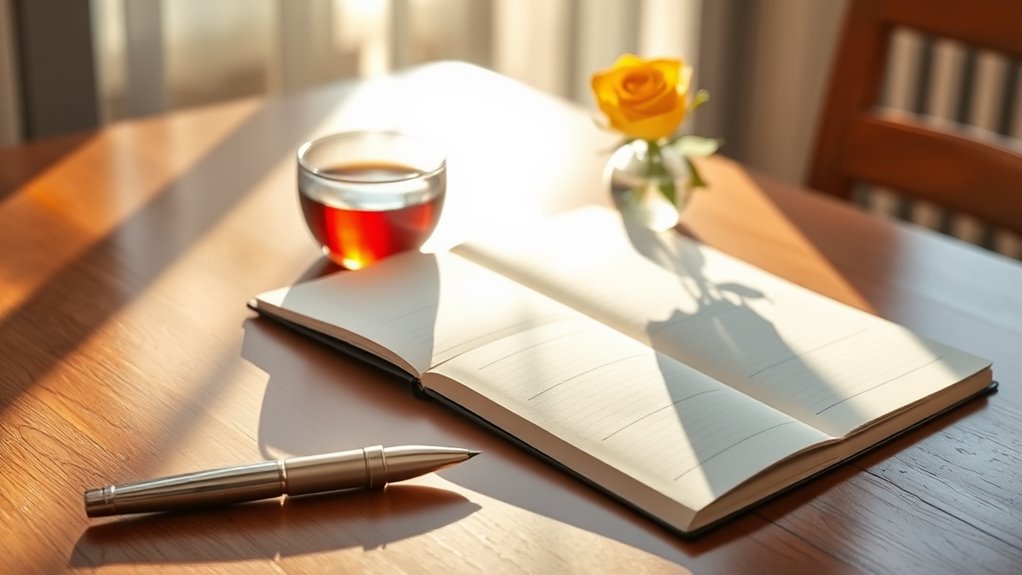Increase Happiness With Effective Gratitude Techniques!
To boost your happiness, embrace gratitude techniques like daily journaling and mindful appreciation. Keeping a gratitude journal helps you focus on positivity, while mindfulness deepens your appreciation for life’s small moments. Writing letters of gratitude can strengthen connections, and sharing your thanks with others reinforces these positive feelings. Reflecting on what you’re grateful for, especially during tough times, builds resilience. Discover how integrating these practices into your daily routine can further transform your happiness.
Key Takeaways
- Maintain a daily gratitude journal to rewire your brain towards positivity and abundance.
- Write heartfelt letters of gratitude to strengthen connections and enhance emotional well-being.
- Practice mindful appreciation by reflecting on small moments that bring joy and happiness.
- Visualize joyful experiences regularly to enhance feelings of gratitude and well-being.
- Embrace gratitude even during challenges by focusing on lessons learned and positive aspects.
Understanding Gratitude and Its Impact on Happiness
Gratitude is a powerful emotion that can greatly enhance your happiness. When you regularly practice gratitude, you’re not just acknowledging the positive aspects of your life; you’re actively reshaping your mindset.
This shift enables you to embrace happiness techniques that foster a more fulfilling emotional state. By focusing on what you appreciate, you cultivate optimism and reduce negative thoughts.
You might start a gratitude journal or express your appreciation to others, reinforcing connections that elevate your mood. As you consistently integrate these practices into your daily routine, you’ll find that your overall sense of well-being improves.
Embracing gratitude isn’t just an isolated act; it’s a transformative journey that profoundly impacts your happiness and life satisfaction. Additionally, simple practices for daily joy can further amplify the effects of gratitude in your life.
The Science Behind Gratitude and Well-Being
Research shows that regularly practicing gratitude can lead to significant improvements in well-being. When you actively acknowledge what you’re thankful for, you trigger positive neurochemical changes in your brain, enhancing mood and reducing stress.
Studies reveal that gratitude promotes the release of dopamine and serotonin, neurotransmitters linked to happiness. This biological response can rewire your mindset, fostering resilience against negative emotions. By shifting your focus from what’s lacking to what you appreciate, you cultivate a more constructive worldview.
In addition, gratitude strengthens social bonds, which are essential for emotional health. Unlocking the power of gratitude is not just recognizing your blessings; you’re also reinforcing a mental framework that promotes lasting happiness and well-being. It’s a powerful tool in your pursuit of a fulfilled life.
Daily Gratitude Journaling
While you might think of gratitude as just a feel-good concept, daily gratitude journaling can transform your outlook on life. By consistently articulating what you’re thankful for, you can rewire your brain to focus on positivity and abundance. This practice is not only beneficial for mental health but can also be a pathway to enhancing overall happiness.
Here’s a simple structure to guide your journaling:
| Date | What I’m Grateful For | Reflection |
|---|---|---|
| 01/01/2023 | A supportive friend | Strengthens my network. |
| 01/02/2023 | A sunny day | Boosts my mood. |
| 01/03/2023 | Achieving a personal goal | Builds confidence. |
Take just a few minutes each day to fill out this table. You’ll cultivate resilience and a deeper appreciation for life’s gifts, paving the way for lasting happiness.
Practicing Mindful Gratitude
Practicing mindful gratitude helps you appreciate the small moments in life. By combining techniques from daily gratitude journaling with mindful appreciation, you can deepen your sense of thankfulness. Let’s explore how these practices can enhance your overall happiness. Additionally, incorporating daily gratitude practices can lead to a brighter outlook on life by fostering positivity and resilience.
Daily Gratitude Journaling
If you want to cultivate happiness and foster a positive mindset, daily gratitude journaling can be an effective practice. This activity not only sharpens your focus on the positive aspects of your life but also helps you reflect deeply. Dedicate a few minutes each day to jot down what you’re thankful for.
Here’s how to structure your journaling:
| Time of Day | Gratitude Focus |
|---|---|
| Morning | Write three new things you appreciate. |
| Afternoon | Note a kind act you received or gave. |
| Evening | Reflect on a pleasant moment from your day. |
Mindful Appreciation Techniques
Mindful appreciation techniques can transform your approach to gratitude, allowing you to fully experience and savor each moment. Start by focusing your attention on the present. When you notice something beautiful—a sunset or a smile—take a deep breath and absorb the experience. Consider what you appreciate about it and let those feelings wash over you.
Try setting aside a few minutes each day to engage your senses deeply. Feel the texture of an object, listen intently to nature, or taste your food mindfully.
Reflect on these moments in your gratitude journal. By anchoring your daily experiences in mindfulness, you cultivate a richer sense of appreciation that enhances your overall happiness, revealing the profound power of gratitude in your life.
Expressing Gratitude Through Letters
Writing letters of gratitude can transform your connections and elevate your mood. It’s not just about saying thank you; it’s an opportunity to express your feelings in a meaningful way.
Let’s explore the benefits of writing these letters, tips to make them effective, and some examples you can draw inspiration from. Additionally, engaging in this practice can significantly enhance your overall well-being by fostering a deeper sense of appreciation in your daily life.
Benefits of Writing Letters
Although many people express gratitude verbally, putting pen to paper can deepen the impact of those feelings. Writing letters allows you to articulate your appreciation in a focused, tangible way.
This practice not only solidifies your gratitude but also creates a lasting reminder for both you and the recipient. When you take the time to craft a letter, you’re more likely to reflect on the specific reasons behind your gratitude, reinforcing positive emotions within yourself.
In addition, a letter becomes a cherished keepsake, offering the recipient a source of joy long after it’s received. Ultimately, writing letters fosters emotional connection and sincerity, making your expressions of gratitude more meaningful and influential in both your life and theirs.
Tips for Effective Letters
Crafting an effective gratitude letter requires a few key strategies to truly convey your appreciation.
First, be specific about what you’re grateful for. Mention particular actions or qualities that made a difference, as this adds authenticity.
Second, write in a sincere tone; let your genuine feelings shine through. Use clear, straightforward language, and avoid overly complex sentences.
Third, keep it concise. Aim for clarity, ensuring that your main message isn’t lost in excessive detail.
Finally, don’t forget to express how their actions impacted you—show them the significance of their efforts.
Examples of Gratitude Letters
When you take the time to express your gratitude through a letter, it not only brightens someone else’s day but also reinforces your own feelings of happiness.
Consider writing to a mentor who guided you through challenges. Begin by acknowledging their specific support and the impact it had on your life.
Similarly, pen a note to a friend, recalling a shared memory that brought you joy, expressing appreciation for their presence during tough times.
For a family member, highlight the sacrifices they’ve made and the love they’ve shown.
The Power of Gratitude Reflection
Reflecting on the things you’re grateful for can greatly boost your overall happiness. This simple practice can help you recognize the positive aspects of your life while fostering a sense of abundance. Here’s how you can effectively structure your reflections:
| Aspect | Reflection Technique |
|---|---|
| Relationships | Write a thank-you note to someone important. |
| Personal Achievements | List three recent successes. |
| Nature | Spend a moment in quiet observation of your surroundings. |
| Daily Moments | Keep a daily gratitude journal. |
Gratitude Visualizations
Gratitude visualizations can be a powerful tool to enhance your sense of well-being. By vividly imagining the things you’re grateful for, you help solidify those positive feelings.
Here’s how to effectively practice gratitude visualizations:
- Close your eyes and take a few deep breaths to center yourself.
- Visualize a specific person or experience that brings you joy.
- Engage your senses; feel the emotions, see the colors, and hear the sounds associated with your gratitude.
- Express appreciation silently or aloud as if you’re speaking to the source of your gratitude.
- Repeat daily to reinforce these positive neural pathways and amplify your happiness.
Incorporating these visualizations into your routine can transform your perspective and deepen your appreciation for life’s blessings.
Sharing Gratitude With Others
Sharing gratitude with others can considerably boost your happiness and strengthen your relationships. By expressing appreciation regularly, whether through a simple thank you or thoughtful notes, you create a positive ripple effect.
Let’s explore how these small acts can make a big difference in your life and the lives of those around you.
Expressing Appreciation Regularly
When you take a moment to express appreciation to those around you, you not only brighten their day but also enhance your own sense of well-being.
Regularly sharing gratitude strengthens relationships and fosters a positive environment. Here are some effective ways to express your appreciation:
- Compliment someone’s hard work or unique qualities.
- Acknowledge the little things they do that often go unnoticed.
- Offer support and recognition during challenges.
- Celebrate their achievements, big or small.
- Simply say “thank you” and mean it.
Each act of appreciation reinforces your connections and cultivates joy in your life.
By making expression of gratitude a habit, you’ll notice an increase in your overall happiness and fulfillment.
Writing Thank You Notes
Although it may seem old-fashioned, writing thank you notes remains a powerful way to express your appreciation. This tangible act fosters deeper connections and highlights the significance of each gesture you’ve received. When you sit down to write, focus on specific details to make the note personal. Mention what you appreciated and how it impacted you. This depth shows genuine gratitude and reinforces relationships.
Set aside time each week to write at least one note—this practice not only cultivates gratitude but also incorporates mindfulness into your routine. You’ll find that as you express appreciation, you increase your own happiness.
Furthermore, the recipient feels valued, creating a ripple effect of positivity that enhances your social bonds and overall well-being.
Gratitude in Challenging Times
Embracing gratitude during challenging times can be a powerful tool that helps you navigate difficulties and cultivate resilience. Acknowledging what you’re thankful for can shift your perspective and reveal strength when you need it most.
Here are five effective techniques to practice gratitude amid adversity:
- Reflect daily on three things you’re grateful for.
- Keep a gratitude journal to document positive experiences.
- Share your appreciation with others to deepen connections.
- Focus on lessons learned from hardships instead of just the pain.
- Engage in mindfulness practices to help you stay present.
Creating a Gratitude Jar
Amid the challenges life throws your way, incorporating gratitude into your daily routine can be transformative. One powerful technique is creating a Gratitude Jar. This simple yet effective method allows you to capture moments of appreciation in a tangible way.
Grab a jar, decorative or plain, and keep it somewhere visible. Each day, write down something you’re grateful for on a slip of paper and add it to the jar. Over time, you’ll collect a treasure trove of positivity.
When you need a boost, revisit those notes to remind yourself of life’s blessings. This practice not only cultivates your gratitude but also encourages reflection, helping you recognize the abundance around you.
Master this technique, and watch your happiness grow!
Integrating Gratitude Into Daily Routines
Integrating gratitude into your daily routines can greatly enhance your overall well-being. By cultivating this practice, you’ll nurture positivity and resilience every day.
Consider implementing these techniques:
-
Start your day with a gratitude mantra or affirmation.
-
Keep a gratitude journal**** in which you write three things you appreciate each evening.
-
Express appreciation to a colleague or friend daily, fostering deeper connections.
-
Incorporate gratitude breaks**** during the day to reflect on positive experiences.
-
End your day with a moment of mindfulness, mentioning what you’re thankful for before sleep.
These simple yet powerful strategies will seamlessly weave gratitude into your life, promoting a mindset of abundance and happiness.
Take action today, and watch your life transform.
Frequently Asked Questions
Can Gratitude Practices Improve Physical Health Too?
Yes, gratitude practices can enhance your physical health. They reduce stress, boost immunity, and improve sleep. By regularly acknowledging what you appreciate, you foster a positive mindset that translates into better overall well-being.
How Long Does It Take to Feel the Effects of Gratitude?
You might start feeling the effects of gratitude within a few days. Consistent practice amplifies the benefits, enhancing your mindset and well-being over weeks. Stay committed, and you’ll witness profound changes in your outlook.
Is There a Specific Time of Day to Practice Gratitude?
Imagine sunrise illuminating the sky; that’s your cue. Practicing gratitude in the morning sets a positive tone for your day. Embrace this ritual, and you’ll cultivate a mindset that welcomes abundance and joy.
Can Gratitude Techniques Help Reduce Anxiety or Depression?
Absolutely, gratitude techniques can greatly reduce anxiety or depression. By regularly reflecting on what you’re thankful for, you shift focus from negative thoughts, fostering a more positive mindset that nurtures emotional resilience and improves overall well-being.
What if I Struggle to Feel Grateful Sometimes?
Sometimes, you’re like a garden missing sunlight. Try focusing on small joys, like a warm coffee or a friend’s smile. These moments can nurture your gratitude, helping you blossom despite those occasional struggles to feel thankful.





